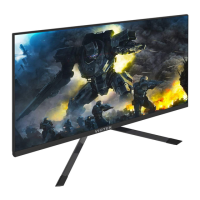10
Section 7: Basic Operation
1. Insert one end of the DP cable into your PC’s graphics card. Other connection types may
be used. Additional cables not included.
For optimal refresh rate (or “performance”), it is recommended to use a DP (display
port) or HDMI cable with the monitor’s corresponding connector.
2. Connect the other end of the cable to the corresponding connector on your monitor.
DP Connector
HDMI Connectors
3. Connect the power cable to your monitor then connect the other end to your power
source. It is recommended that you use a surge protector with adequate voltage if a wall
outlet cannot be reached directly.
4. Locate the power button on the monitor and press it to turn the monitor on.
FreeSync
The feature itself is off by default. In order to use this feature, please note you must have
hardware with FreeSync capability, a DP or HDMI cable, and the latest graphic drivers. To use
this feature, connect your computer and monitor with a DP or HDMI cable. After connecting,
you may receive a prompt to enable the feature on your computer. If you do not receive the
prompt, you may need to enable the function in your graphics card menu. See your graphics
card manufacturer’s documentation for instructions on how to turn on and/or enable FreeSync.
Section 8: Indicator Light
Indicator Light
Solid blue light indicates power is on and the monitor is operating normally. Flashing blue light
indicates no video source has been detected. Red light indicates that no horizontal or vertical
signal has been detected or voltage is low. Please ensure your computer is on and all video
cables are fully inserted and/or connected.

